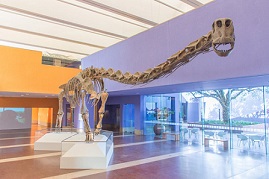
Paluxysaurus Dinosaur, a member of the Sauropod family, existed during the Early Cretaceous period, approximately 112 to 105 million years ago. This massive, long-necked dinosaur was first unveiled to the world in the 1970s through a series of remarkable discoveries in Texas, USA. The name Paluxysaurus pays tribute to the Paluxy River, near which its fossils were found, and the Greek word sauros, meaning lizard. These fossils, including skeletal remains and tracks, have provided invaluable insights into the life and times of this ancient behemoth.
Paluxysaurus holds its place as one of the largest known dinosaurs, boasting a prodigious size that captures the imagination. With estimated lengths exceeding 60 feet (18 meters) and towering heights, Paluxysaurus ruled the Late Cretaceous landscapes as an emblem of prehistoric grandeur.
| Name: | Paluxysaurus dinosaurs |
| Size: | Around 60 feet (18 meters). |
| Main Facts: | Paluxysaurus was one of the largest sauropods, showcasing Late Cretaceous gigantism and herbivorous adaptation in North America. |
As a sauropod, Paluxysaurus sported the classic features of this iconic group: a long neck, massive body, pillar-like legs, and a powerful tail. Its colossal frame and adaptations for quadrupedal locomotion allowed it to traverse vast territories and exploit abundant vegetation.

Paluxysaurus, like its sauropod relatives, was a dedicated herbivore. Its remarkable dental adaptations and jaws were tailored for processing plant matter, enabling it to graze on the lush flora that thrived in the Late Cretaceous ecosystems.
Paluxysaurus inhabited a dynamic world, sharing its habitat with an array of prehistoric creatures. It coexisted with other dinosaurs, pterosaurs, and ancient reptiles, contributing to the intricate web of life that shaped the ecosystems of the time.
Paluxysaurus, a colossal sauropod of the Late Cretaceous, showcased a majestic physique characterized by its towering size, elongated neck, robust body, and quadrupedal stance. Its massive frame, estimated to exceed 60 feet in length, enabled it to browse on the abundant vegetation that flourished in its ancient habitat. With a herbivorous diet, Paluxysaurus possessed specialized dental adaptations to process plant material efficiently. Fossil discoveries from the Glen Rose Formation in Texas unveiled its remarkable skeletal structure and provided insights into its quadrupedal locomotion and ecological role.
Coexisting with a diverse array of dinosaurs and prehistoric creatures, Paluxysaurus thrived in an intricate ecosystem, contributing to the intricate web of interactions in the Late Cretaceous world. As an enduring symbol of prehistoric grandeur, Paluxysaurus continues to inspire awe and curiosity about the magnificence of Earth's distant past.
Paluxysaurus, a sauropod, stood out for its colossal size, reaching lengths comparable to other giant herbivores like Argentinosaurus. Its long neck and tail, akin to those of Diplodocus, illustrate common sauropod features.
Paluxysaurus' quadrupedal stance, typical of sauropods, contrasts with the bipedal posture of theropods like Velociraptor, showcasing the varied locomotion strategies among dinosaurs.
Fossil evidence places Paluxysaurus in North America, resembling other sauropods like Brachiosaurus, which were also discovered on the continent.
Comparing Paluxysaurus' long neck to the short-necked stegosaurs emphasizes the diversity in neck length and potential feeding habits among herbivorous dinosaurs.
Paluxysaurus lived alongside other dinosaurs, such as the duck-billed hadrosaurs and armored ankylosaurs, providing insights into the complex interactions within Late Cretaceous ecosystems.
Bonebeds and trackways suggest that Paluxysaurus may have exhibited social behaviors similar to those of other sauropods, like Apatosaurus, which were also known to form herds.
Comparing Paluxysaurus' vertebrae with those of other sauropods allows scientists to uncover anatomical variations and potential adaptations in neck flexibility and support.